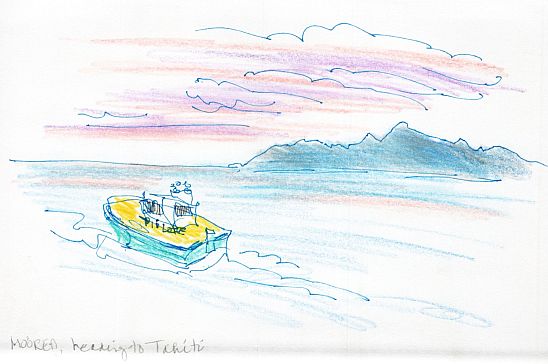The locals, and the tourist industry too, call the island of Taha’a the vanilla island. We had a tour of one family run farm. I think they are all family run.
I drew the supporting plant and the thin green vanilla vine. Each plant has to be hand-pollinated, as the bees in the islands don’t recognize the plant. I think this means it is not native to the islands. So whole families are in the vanilla woods with little brushes to move the pollen to the appropriate part of the flower to start the growth of the bean. The farmer we met called them vanilla sticks.
We got the full lecture why Tahitian vanilla is far superior to Madagascar vanilla. In essence, it is left on the vine until ripe, then massaged a lot to distribute the oils throughout the entire bean.
The coconut shells keep the chickens away from the plants.
I never saw a sprouting coconut before, so it was a must draw.
The chickens are everywhere to eat the centipedes.
Occasionally I draw from memory if the memory is strong enough. The last stop on our cultural tour around the island of Taha’a was this beach along a lagoon.
The holes are the homes of land crabs. The guide told us that the crabs come out of their holes during a full moon. At this time, the locals collect them and bring them home for a delicious treat. But first, the crabs need to be kept in a box and fed shredded coconut for a month to improve the taste of the flesh.
On the right is my memory of the flat black stones that make up a marae, an ancestral burial ground. One guide pointed out to us on the first day that no moss or anything grows on the sacred rocks. I looked carefully. She was right. Sort of spooky.
One day the cruise ship program called for a barbeque lunch picnic on a motu. I think motu means small uninhabited coral island. We had to wade to the land through waist deep water for an extra bit of cooling fun.
A couple got married on the motu. The bride wore a white bikini with a short lacy coverup.
It made an entertaining contrast to draw the cruise ship in the lagoon with a two person kayak in the foreground.
The volcanic profiles of the islands are fascinating and fun to draw.
We did go ashore in Bora Bora because we had signed up for something called an aquabike or underwater scooter. Honestly, we didn’t understand what we were signing up for. A better description is a two person submarine, where your head stays dry in a bubble of air, and the rest of you is wet. Bruce drove, and I gripped my seat. We were ten feet below the water surface for 30 minutes. Bruce followed the diver as he showed us the underwater sights. Fish food hung from the scooter so we had a lot of gorgeous looking freeloaders to watch.
Our diver guide was the grandson of the inventor. These machines exist in only two places in the world, both operated by this family.
We didn’t go onto Mo’orea as it was raining and I had some paintings I wanted to finish before an on-ship presentation.
The crossing between Mo’orea and Tahiti was the only rough water we encountered. It reminded me of the English Channel in that regard.
Even the tugboat was colorful and worthy of a sketch.
On our last day we had another two hour tour of Tahiti, south of Pape’ete. It was like a bookend to the first day’s tour to the north of the city. Here we are on a very windy day on a black sand beach. The people on the water with their windsails and kites seemed to be having a grand time.
French Polynesia did not disappoint. I think about it everyday.
A note about the native language. As seen in my writing above, it often features an apostrophe between two identical vowels. This appears to be optional, but highly recommended for clarity. It indicates that the vowels are pronounced separately, with a brief stop in between, and not combined into a long vowel as in English and other languages. We learned in an onboard talk by a Dartmouth linguistics professor that this is often characteristic of languages that are a bit higher in the family tree than the more contemporary ones, and that the concept goes away as languages evolve into more simple forms. Yes, I got a few of the apostrophes wrong in the notes on my drawings.
We also learned that the language is spoken without stress on specific syllables. It was rather jarring to hear the familiar word Samoa pronounced that way.
Sam oh ah, with no stress













No comments:
Post a Comment